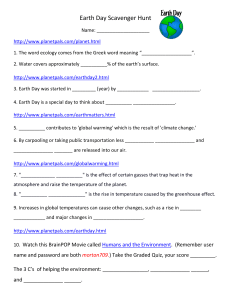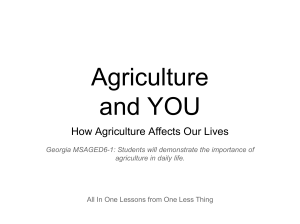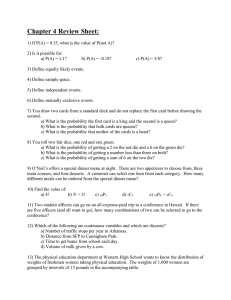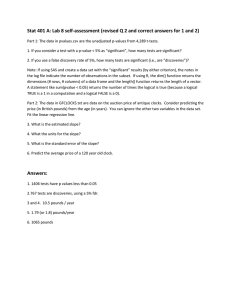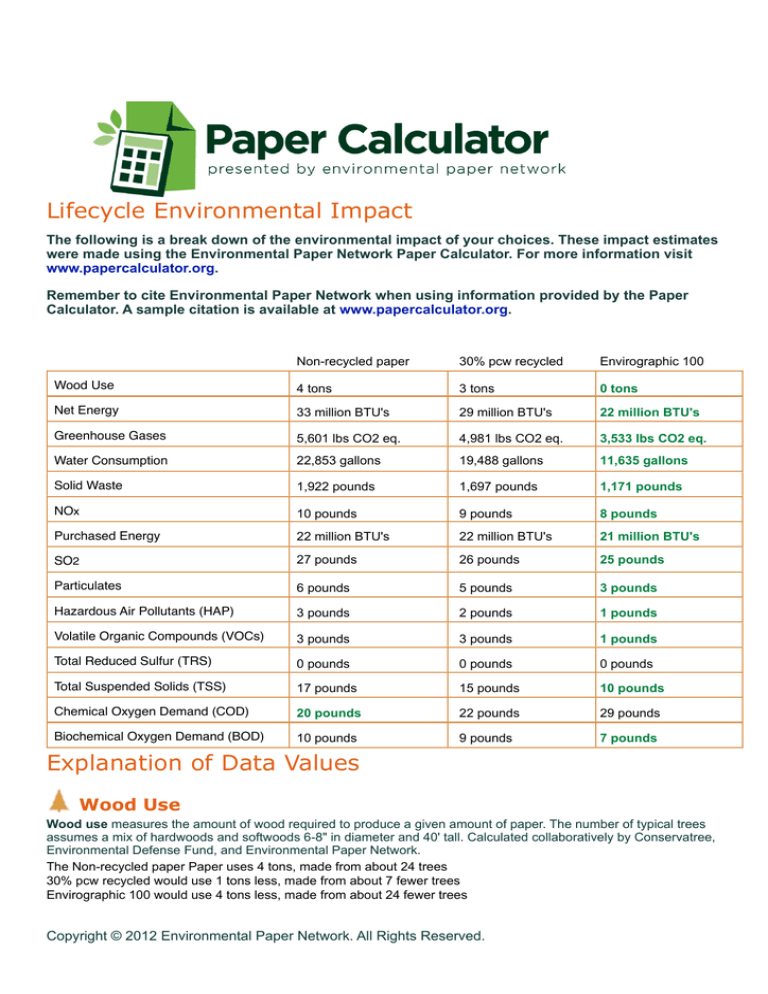
Lifecycle Environmental Impact
The following is a break down of the environmental impact of your choices. These impact estimates
were made using the Environmental Paper Network Paper Calculator. For more information visit
www.papercalculator.org.
Remember to cite Environmental Paper Network when using information provided by the Paper
Calculator. A sample citation is available at www.papercalculator.org.
Non-recycled paper
30% pcw recycled
Envirographic 100
Wood Use
4 tons
3 tons
0 tons
Net Energy
33 million BTU's
29 million BTU's
22 million BTU's
Greenhouse Gases
5,601 lbs CO2 eq.
4,981 lbs CO2 eq.
3,533 lbs CO2 eq.
Water Consumption
22,853 gallons
19,488 gallons
11,635 gallons
Solid Waste
1,922 pounds
1,697 pounds
1,171 pounds
NOx
10 pounds
9 pounds
8 pounds
Purchased Energy
22 million BTU's
22 million BTU's
21 million BTU's
SO2
27 pounds
26 pounds
25 pounds
Particulates
6 pounds
5 pounds
3 pounds
Hazardous Air Pollutants (HAP)
3 pounds
2 pounds
1 pounds
Volatile Organic Compounds (VOCs)
3 pounds
3 pounds
1 pounds
Total Reduced Sulfur (TRS)
0 pounds
0 pounds
0 pounds
Total Suspended Solids (TSS)
17 pounds
15 pounds
10 pounds
Chemical Oxygen Demand (COD)
20 pounds
22 pounds
29 pounds
Biochemical Oxygen Demand (BOD)
10 pounds
9 pounds
7 pounds
Explanation of Data Values
Wood Use
Wood use measures the amount of wood required to produce a given amount of paper. The number of typical trees
assumes a mix of hardwoods and softwoods 6-8" in diameter and 40' tall. Calculated collaboratively by Conservatree,
Environmental Defense Fund, and Environmental Paper Network.
The Non-recycled paper Paper uses 4 tons, made from about 24 trees
30% pcw recycled would use 1 tons less, made from about 7 fewer trees
Envirographic 100 would use 4 tons less, made from about 24 fewer trees
Copyright © 2012 Environmental Paper Network. All Rights Reserved.
Net Energy
The Paper Calculator includes an energy credit for energy that is created by burning paper – or the methane that
decomposing paper creates – at the end of its life. The Net Energy takes the total amount of energy required to make the
paper over its life cycle, and subtracts this energy credit. If most of the energy used to make the paper is purchased, then
the energy credit might make the Net Energy lower than the Purchased Energy. The average U.S. household uses 91
million BTUs of energy in a year.
The Non-recycled paper Paper uses 33 million BTU's, the equivalent of about 0 homes/year
30% pcw recycled Paper uses -4 million BTU's more, the equivalent of about 0 more homes/year
Envirographic 100 Paper uses -11 million BTU's more, the equivalent of about 0 more homes/year
Greenhouse Gases
Greenhouse gases, including carbon dioxide (CO2) from burning fossil fuels and methane from paper decomposing in
landfills, contribute to climate change by trapping energy from the sun in the earth's atmosphere. The unit of measure is
CO2 equivalents. The average car emits 11,013 pounds of CO2 in a year.
The Non-recycled paper Paper produces 5,601 pounds CO2 equiv., the equivalent of about 1 cars/year
The 30% pcw recycled Paper produces 620 fewer pounds CO2 equiv., the equivalent of about 1 fewer cars/year
The Envirographic 100 Paper produces 2,068 fewer pounds CO2 equiv., the equivalent of about 1 fewer cars/year
Water Consumption
Water Consumption measures the amount of process and cooling water that is consumed or degraded throughout the
life cycle of the paper product. The largest components of water consumption come from the production of purchased
electricity, and the use of process and cooling water at pulp and paper mills. Water volume indicates both the amount of
fresh water needed and the potential impact of discharges on the receiving waters. 1 Olympic-sized swimming pool holds
660,430 gallons.
The Non-recycled paper Paper uses 22,853 gallons, the equivalent of about 0 swimming pools
The 30% pcw recycled Paper uses 3,365 gallons less, the equivalent of about 0 fewer swimming pools
The Envirographic 100 Paper uses 11,218 gallons less, the equivalent of about 0 fewer swimming pools
Solid Waste
Solid Waste includes sludge and other wastes generated during pulp and paper manufacturing, and used paper disposed
of in landfills and incinerators. 1 fully-loaded garbage truck weighs an average of 28,000 pounds (based on a rear-loader
residential garbage truck).
The Non-recycled paper Paper produces 1,922 pounds, the equivalent of about 0 garbage trucks
The 30% pcw recycled Paper produces 225 pounds less, the equivalent of about 0 fewer garbage trucks
The Envirographic 100 Paper produces 751 pounds less, the equivalent of about 0 fewer garbage trucks
Nitrogen oxides (NOx)
Nitrogen Oxides (NOx, which include NO and NO2) are products of the combustion of fuels that contain nitrogen. NOx
contribute to acid rain and can react with volatile organic compounds and sunlight in the lower atmosphere to form ozone,
a key component of urban smog. The average 18-wheel truck emits 261 pounds of NOx in a year.
The Non-recycled paper Paper produces 10 pounds, the equivalent of about 0 18-wheelers/year
The 30% pcw recycled Paper produces 1 pounds less, the equivalent of about 0 fewer 18-wheelers/year
The Envirographic 100 Paper produces 2 pounds less, the equivalent of about 0 fewer 18-wheelers/year
Purchased Energy
A subset of total energy, purchased energy measures how much energy comes from purchased electricity and other
fuels. The unit of measure is British Thermal Units (BTUs). The average U.S. household uses 91 million BTUs of energy in
a year.
The Non-recycled paper Paper uses 22 million BTU's, the equivalent of about 0 homes/year
The 30% pcw recycled Paper uses 0 million BTU's more, the equivalent of about 0 more homes/year
The Envirographic 100 Paper uses 1 million BTU's less, the equivalent of about 0 fewer homes/year
Copyright © 2012 Environmental Paper Network. All Rights Reserved.
Sulfur dioxide (SO2)
Chemical compound produced when boilers burn fuel that contains sulfur. Of the fuels used in the paper industry, oil and
coal generally contain the highest quantities of sulfur. Sulfur dioxide contributes to air pollution problems like acid rain
and smog. The average 18-wheel truck emits 5.5 pounds of SO2 in a year.
The Non-recycled paper Paper produces 27 pounds, the equivalent of about 5 18-wheelers/year
The 30% pcw recycled Paper produces 1 pounds less, the equivalent of about 0 fewer 18-wheelers/year
The Envirographic 100 Paper produces 2 pounds less, the equivalent of about 0 fewer 18-wheelers/year
Particulates
Particulates are small particles generated during combustion, and pose a range of health risks, including asthma and
other respiratory problems, when inhaled. The average urban bus emits 11.2 pounds of particulate matter in a year.
The Non-recycled paper Paper produces 6 pounds, the equivalent of about 1 buses/year
The 30% pcw recycled Paper produces 1 pounds less, the equivalent of about 1 fewer buses/year
The Envirographic 100 Paper produces 3 pounds less, the equivalent of about 1 fewer buses/year
Hazardous Air Pollutants (HAP)
Hazardous Air Pollutants are any of a group of 188 substances identified in the 1990 Clean Air Act amendments
because of their toxicity.
The Non-recycled paper Paper produces 3 pounds
The 30% pcw recycled Paper produces 1 fewer pounds
The Envirographic 100 Paper produces 2 fewer pounds
Volatile Organic Compounds (VOCs)
Volatile Organic Compounds (VOCs) are a broad class of organic gases, such as vapors from solvent and gasoline.
VOCs react with nitrogen oxides (NOx) in the atmosphere to form ground-level ozone, the major component of smog and
a severe lung irritant.
The Non-recycled paper Paper produces 3 pounds
The 30% pcw recycled Paper produces 0 more pounds
The Envirographic 100 Paper produces 2 fewer pounds
Total Reduced Sulfur (TRS)
Total Reduced Sulfur compounds cause the odor associated with kraft pulp mills. Exposure to TRS emissions has been
linked to symptoms including headaches, watery eyes, nasal problems, and breathing difficulties.
The Non-recycled paper Paper produces 0 pounds
The 30% pcw recycled Paper produces 0 more pounds
The Envirographic 100 Paper produces 0 more pounds
Total Suspended Solids (TSS)
Total suspended solids (TSS) measure solid material suspended in mill effluent, which can adversely affect bottomliving organisms upon settling in receiving waters and can carry toxic heavy metals and organic compounds into the
environment. The average home discharges 207 pounds of Total Suspended Solids (TSS) in a year.
The Non-recycled paper Paper produces 17 pounds, the equivalent of about 0 homes/year
The 30% pcw recycled Paper produces 2 pounds less, the equivalent of about 0 fewer homes/year
The Envirographic 100 Paper produces 7 pounds less, the equivalent of about 0 fewer homes/year
Chemical Oxygen Demand (COD)
Chemical Oxygen Demand (COD) measures the amount of oxidizable organic matter in the mill's effluent. Since
wastewater treatment removes most of the organic material that would be degraded naturally in the receiving waters, the
COD of the final effluent provides information about the quantity of more persistent substances discharged into the
receiving water. The average home discharges 465 pounds of Chemical Oxygen Demand (COD) in a year.
The Non-recycled paper Paper produces 20 pounds, the equivalent of about 0 homes/year
The 30% pcw recycled Paper produces 2 pounds more, the equivalent of about 0 more homes/year
The Envirographic 100 Paper produces 9 pounds more, the equivalent of about 0 more homes/year
Copyright © 2012 Environmental Paper Network. All Rights Reserved.
Biochemical Oxygen Demand (BOD)
Biochemical Oxygen Demand (BOD) measures the amount of oxygen that microorganisms consume to degrade the
organic material in the wastewater. Discharging wastewater with high levels of BOD can result in oxygen depletion in the
receiving waters, which can adversely affect fish and other organisms. Average home discharges 186 pounds of
Biochemical Oxygen Demand (BOD) in a year.
The Non-recycled paper Paper produces 10 pounds, the equivalent of about 0 homes/year
The 30% pcw recycled Paper produces 1 pounds less, the equivalent of about 0 fewer homes/year
The Envirographic 100 Paper produces 3 pounds less, the equivalent of about 0 fewer homes/year
The Paper Calculator is based on research done by the Paper Task Force, a peer-reviewed study of the
lifecycle environmental impacts of paper production and disposal. The underlying data in the Paper
Calculator are updated regularly.
Questions? Comments?
Contact Environmental Paper Network
For more information visit www.papercalculator.org.
Copyright © 2012 Environmental Paper Network. All Rights Reserved.
Paper Content and Details:
Paper Name:
Non-recycled paper
30% pcw recycled
Envirographic 100
Paper Grade:
Uncoated Freesheet
Uncoated Freesheet
Uncoated Freesheet
Quantity (per year)
1 tons
1 tons
1 tons
Percent Recycled Content:
0
30
100
Total Pulp Content:
84
84
84
100
70
0
100
70
0
Percentage Kraft Unbleached:
0
0
0
Stone or pressurized groundwood:
0
0
0
Thermomechanical:
0
0
0
0
30
100
Recycled Office Paper:
0
30
100
Recycled newspaper:
0
0
0
Recycled corrugated containers:
0
0
0
Recycled Mixed Paper/ Board:
0
0
0
Elemental Chlorine Free (ECF):
60
42
0
Enhanced EECF:
40
28
0
Linerboard:
0
0
0
Medium:
0
0
0
Integrated:
0
0
0
Non-integrated:
0
0
0
Pulp Types and Sources
Percentage of Virgin Pulp:
Virgin Pulp Types
Percentage Kraft Bleached:
Recycled Pulp Types
Percentage of recycled Pulp:
Kraft Bleaching Technology
Kraft Unbleached Composition
Copyright © 2012 Environmental Paper Network. All Rights Reserved.


